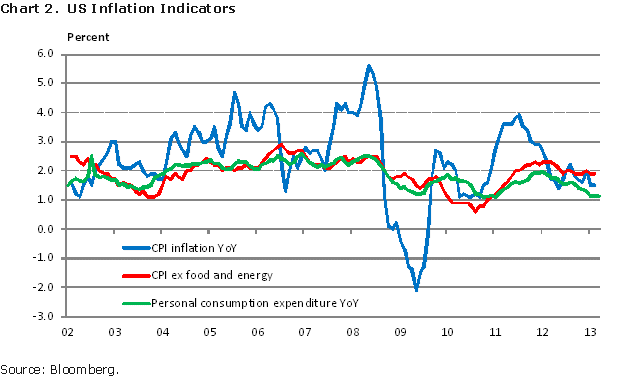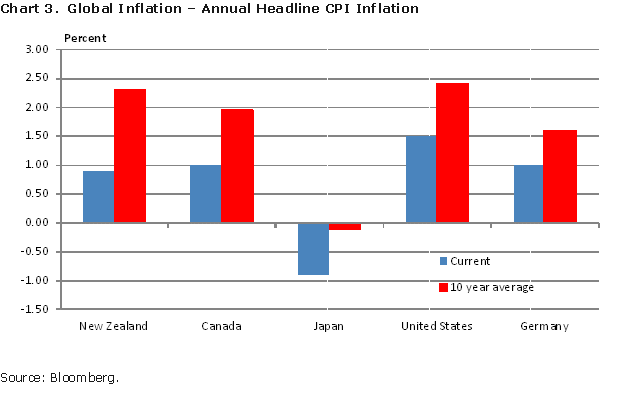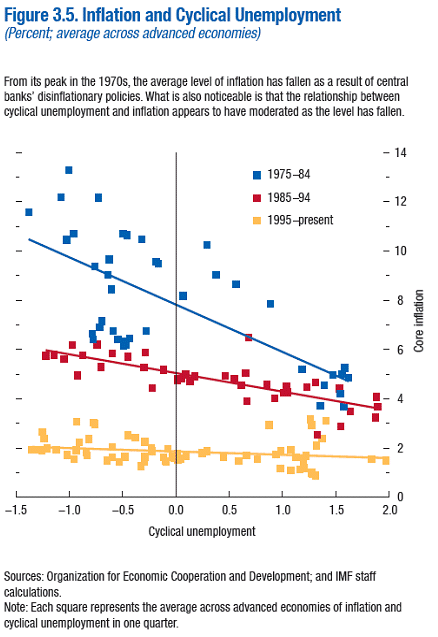Harbour Monthly Commentary: The Threat of Inflation or Deflation
The question is not why we aren’t seeing any inflation but rather why we aren’t experiencing deflation. Expectations of minimal inflation seem to be a self-fulfilling prophecy … for now, anyway.
Wednesday, May 8th 2013, 9:28AM
by Harbour Asset Management
• Global bond yields have fallen back to recent lows, as a soft patch in global economic activity has been followed by a realisation that global inflation has also been falling below target.
• Indeed, the IMF have highlighted that the real puzzle is not why inflation is so low; but rather why we haven’t seen deflation.
• With inflation expectations so firmly anchored, the Federal Reserve, Bank of England, and Bank of Japan are all erring on the side of providing too much stimulus, rather than providing too little.
• While we expect yields to rise from their lows in the medium-term, in our view this requires stronger economic data is required as a catalyst.
• Global growth expectations for 2013 are still broadly the same as the 2.0-2.5% growth delivered in 2012, which seems unlikely to unhinge inflation expectations for now.
Global Bond Yields Back at Lows
Over January and February, the US 10 year bond yield rose from 1.70% to as high as 2.10% as the market’s worst fears about the US fiscal cliff did not eventuate, and the US economy showed continued signs of economic recovery. However, since mid March, the US 10 year bond yield has fallen back to its lows for the year, falling as low at 1.65%.
At first, this move was triggered largely by signs that the US economy had hit a softer patch with business confidence abating and employment growth slowing. At the end of 2012 the US Federal Reserve had introduced the Evans Rule, which made it clear that it intended to keep monetary policy loose as long as unemployment remained above 6.5%. In other words, it had given job growth prominence over inflation in its dual mandate. And the market had focused on the weakness in employment and business confidence over March as a driver of lower yields.

US Federal Reserve Missing its Inflation Target
Through the course of April, it has become clearer that the very low level of US inflation also justifies loose monetary policy for some time yet. Within its dual mandate, the US Federal Reserve targets 2% inflation, with its preferred measure of underlying inflation being the Private Consumption Expenditure Deflator (given that it effectively strips out volatile components of inflation). At 1.2% the Private Consumption Expenditure Deflator is now lower than 2009, when global deflation was a serious concern at the height of the GFC. Over the course of April, a number of voting Governors at the US Federal Reserve have noted in speeches that inflation is “below target”, rather than “near target”.

Inflation Subdued Globally
This trend of lower inflation has not been isolated to the United States, with inflation also falling in many other developed countries. The economic outlook in Europe, in particular, still looks very challenging as austerity measures (designed to improve long-term debt sustainability) hurt the near-term economic outlook. The recent sharp fall in global commodity prices should also work to keep inflation low.

The Threat of Inflation or Deflation
Indeed, economists at the IMF have highlighted that the real puzzle is not why inflation is so low and stable; but rather why we haven’t seen deflation given the vast amount of spare capacity in developed countries since the GFC.
Their conclusion is that inflation expectations have become much more anchored since the advent of inflation targeting, and therefore play a much greater role in determining actual inflation. They show that the Philips Curve has become much flatter – in other words, actual inflation is much less sensitive to real economic activity.

An implication of their research is that, as long as inflation expectations remain well anchored, ongoing monetary stimulus from global central banks is unlikely to result in inflation getting out of control.
We suspect that it is this type of analysis that has influenced policy at the Federal Reserve, Bank of England and Bank of Japan. They have decided to err on the side of providing too much stimulus, rather than providing too little. With both economic activity modest and inflation below target, this points to central banks keeping the taps on full for some time yet.
There are interesting parallels in New Zealand with CPI inflation at 0.9%, outside the 1-3% target range. Does this imply that the RBNZ should be cutting the OCR? Our central view is that inflation in New Zealand will gradually move back to the middle of the target range with no change in the OCR required. However, there is a plausible scenario where CPI inflation remains stubbornly low and the RBNZ feels obliged to cut the OCR to meet their inflation target (despite the Auckland housing market picking up).
Market Outlook
We continue to expect the RBNZ to remain on hold at 2.50% for 2013, balancing the conflicting forces of the Canterbury rebuild and the Auckland housing market against the elevated NZD, drought and fiscal contraction.
It is worth reflecting that the growth outlook in New Zealand is reasonably good in a global context. This month the government revised up the cost of the Canterbury rebuild to $40bn (nearly 20% of NZ GDP), which will provide a unique and lasting source of economic activity.
While official short-term rates in New Zealand and overseas look to be very stable, there is still scope for volatility in long-term bond yields.
Over the medium-to-long-term, we continue to expect a gradual rise in global yields as the US economy eventually moves out of the soft patch of economic activity it has experienced in recent months.
However, we expect this will take some time to occur. Furthermore, with global inflation subdued, central banks are in no hurry to step back from Quantitative Easing policies. This is likely to keep government bond yields relatively low for some time yet and support riskier asset classes.
Christian Hawkesby
Director, Fixed Interest
Harbour Asset Management
Important disclaimer information
| « Tyndall Monthly Commentary:Dangerous Assumptions Impact New Zealand | Hamish Douglass Unplugged - Latest Video from Adviser Briefing - August 2012 » |
Special Offers
Comments from our readers
No comments yet
Sign In to add your comment
| Printable version | Email to a friend |









